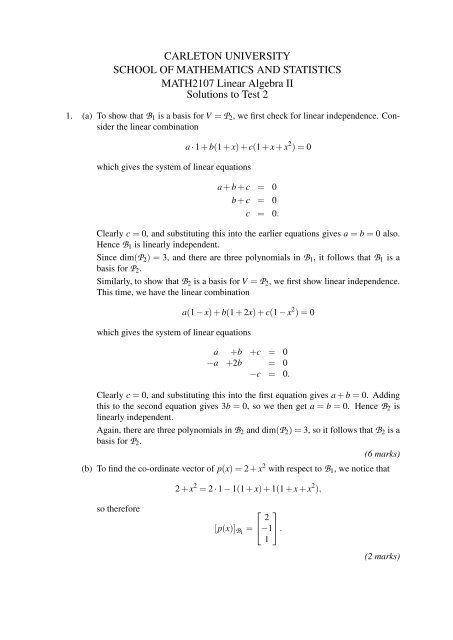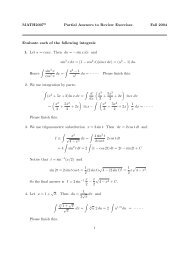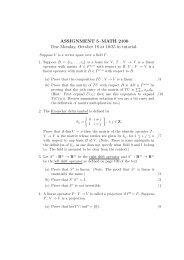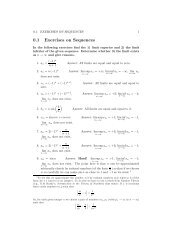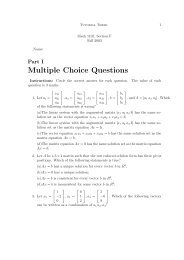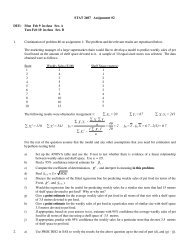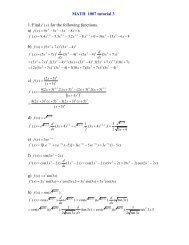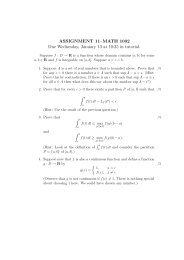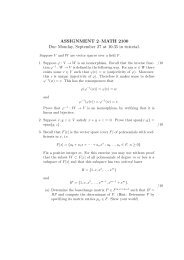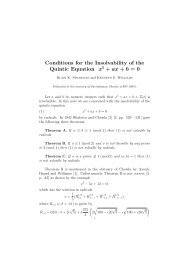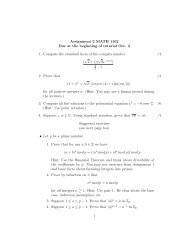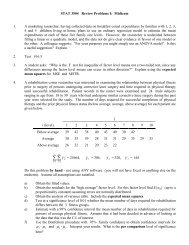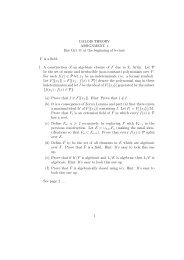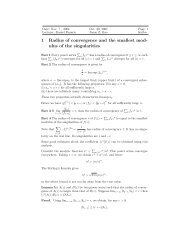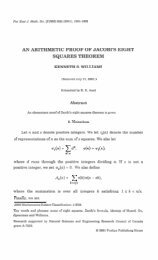Solutions - School of Mathematics and Statistics - Carleton University
Solutions - School of Mathematics and Statistics - Carleton University
Solutions - School of Mathematics and Statistics - Carleton University
Create successful ePaper yourself
Turn your PDF publications into a flip-book with our unique Google optimized e-Paper software.
CARLETON UNIVERSITY<br />
SCHOOL OF MATHEMATICS AND STATISTICS<br />
MATH2107 Linear Algebra II<br />
<strong>Solutions</strong> to Test 2<br />
1. (a) To show that B1 is a basis for V = P2, we first check for linear independence. Consider<br />
the linear combination<br />
a · 1 + b(1 + x) + c(1 + x + x 2 ) = 0<br />
which gives the system <strong>of</strong> linear equations<br />
a + b + c = 0<br />
b + c = 0<br />
c = 0.<br />
Clearly c = 0, <strong>and</strong> substituting this into the earlier equations gives a = b = 0 also.<br />
Hence B1 is linearly independent.<br />
Since dim(P2) = 3, <strong>and</strong> there are three polynomials in B1, it follows that B1 is a<br />
basis for P2.<br />
Similarly, to show that B2 is a basis for V = P2, we first show linear independence.<br />
This time, we have the linear combination<br />
a(1 − x) + b(1 + 2x) + c(1 − x 2 ) = 0<br />
which gives the system <strong>of</strong> linear equations<br />
a +b +c = 0<br />
−a +2b = 0<br />
−c = 0.<br />
Clearly c = 0, <strong>and</strong> substituting this into the first equation gives a + b = 0. Adding<br />
this to the second equation gives 3b = 0, so we then get a = b = 0. Hence B2 is<br />
linearly independent.<br />
Again, there are three polynomials in B2 <strong>and</strong> dim(P2) = 3, so it follows that B2 is a<br />
basis for P2.<br />
(6 marks)<br />
(b) To find the co-ordinate vector <strong>of</strong> p(x) = 2 + x 2 with respect to B1, we notice that<br />
so therefore<br />
2 + x 2 = 2 · 1 − 1(1 + x) + 1(1 + x + x 2 ),<br />
[p(x)]B1 =<br />
⎡ ⎤<br />
2<br />
⎣−1⎦.<br />
1<br />
(2 marks)
(c) Let B1 be the matrix whose columns are the co-ordinate vectors <strong>of</strong> B1 with respect<br />
to the st<strong>and</strong>ard basis, <strong>and</strong> likewise B2 the same matrix but for B2. So we have<br />
⎡<br />
1 1<br />
⎤<br />
1<br />
B1 = ⎣0<br />
1 1⎦<br />
0 0 1<br />
<strong>and</strong><br />
B2 =<br />
⎡<br />
1 1<br />
⎤<br />
1<br />
⎣−1<br />
2 0 ⎦.<br />
0 0 −1<br />
To use the Gauss–Jordan Method, we take the 3 × 6 matrix [B2 | B1], <strong>and</strong> apply<br />
elementary row operations until the left-h<strong>and</strong> matrix is the identity:<br />
⎡<br />
1 1 1 1 1<br />
⎤<br />
1<br />
⎡<br />
1 1 1 1 1<br />
⎤<br />
1<br />
⎣ −1 2 0 0 1 1 ⎦ ∼ ⎣ 0 3 1 1 2 2 ⎦<br />
0 0 −1 0 0 1 0<br />
⎡<br />
1<br />
0<br />
1<br />
−1<br />
1<br />
0<br />
1<br />
0<br />
1<br />
1<br />
⎤<br />
1<br />
∼<br />
∼<br />
⎣ 0<br />
0<br />
⎡<br />
1<br />
⎣<br />
1<br />
0<br />
0<br />
1 1 2 2 ⎦<br />
3 3 3 3<br />
−1 0 0 1<br />
2 0 1<br />
2 1 1<br />
3 3 3 3<br />
1 ∼<br />
0<br />
⎡<br />
1<br />
⎣<br />
0<br />
0<br />
⎤<br />
1 2 2 ⎦<br />
3 3 3 3<br />
1 0 0 −1<br />
0 2 0 1<br />
1<br />
3 3 1<br />
0 1 0 0<br />
⎤<br />
2<br />
3 3 1 ⎦<br />
1 0 0 −1<br />
So the change-<strong>of</strong>-basis matrix is the matrix on the right, i.e.<br />
PB2←B1 =<br />
⎡ 2<br />
3<br />
⎣ 1<br />
3<br />
0<br />
1<br />
3<br />
2<br />
3<br />
0<br />
⎤<br />
1<br />
1 ⎦.<br />
−1<br />
(7 marks)<br />
(d) To find the co-ordinate vector <strong>of</strong> p(x) with respect to B2, we take the one we obtained<br />
in (b) <strong>and</strong> multiply it by the change-<strong>of</strong>-basis matrix we obtained in (c):<br />
[p(x)]B2<br />
= PB2←B1 [p(x)]B1<br />
⎡ 2 1<br />
3 3<br />
= ⎣<br />
1<br />
1 2<br />
3 3 1<br />
⎤⎡<br />
⎤<br />
2<br />
⎦⎣−1⎦<br />
0 0 1 1<br />
⎡ ⎤<br />
2<br />
= ⎣ 1 ⎦.<br />
−1<br />
(2 marks)
2. (a) T (A) = trace(A) is a linear transformation from M33 to R, as both conditions hold.<br />
For all matrices A,B <strong>and</strong> scalars c, we have<br />
<strong>and</strong><br />
T (A + B) = (a11 + b11) + (a22 + b22) + (a33 + b33)<br />
= (a11 + a22 + a33) + (b11 + b22 + b33)<br />
= T (A) + T (B)<br />
T (cA) = ca11 + ca22 + ca33<br />
= c(a11 + a22 + a33)<br />
= cT (A).<br />
(b) The map T : M22 → M22 defined by<br />
<br />
a<br />
T<br />
c<br />
<br />
b c<br />
=<br />
d d<br />
<br />
a<br />
b<br />
<br />
a<br />
is a linear transformation. Let A =<br />
c<br />
<br />
b<br />
x<br />
<strong>and</strong> B =<br />
d<br />
z<br />
<br />
y<br />
. Then we have<br />
w<br />
T (A + B) =<br />
=<br />
=<br />
<br />
a + x b + y<br />
T<br />
c + z d + w<br />
<br />
c + z a + x<br />
d + w b + y<br />
<br />
c a z x<br />
+<br />
d b w y<br />
<strong>and</strong> also<br />
(where k is any scalar).<br />
(c) The map T : M22 → M22 defined by<br />
<br />
a b<br />
T =<br />
c d<br />
= T (A) + T (B)<br />
<br />
ka kb<br />
T (kA) = T<br />
kc kd<br />
<br />
kc ka<br />
=<br />
kd kb<br />
<br />
c a<br />
= k<br />
d b<br />
= kT (A)<br />
<br />
1<br />
<br />
a + b<br />
c + d −1<br />
is not a linear transformation, since T (0) = 0: observe that<br />
<br />
0<br />
T<br />
0<br />
<br />
0 1<br />
=<br />
0 0<br />
<br />
0 0<br />
=<br />
−1 0<br />
<br />
0<br />
.<br />
0<br />
(3 marks)<br />
(3 marks)<br />
(3 marks)
3. To show for any linear transformation T : V → W that T (0V ) = 0W , we start by choosing<br />
any vector v ∈ V . Then (by a result about vector spaces), 0v = 0V . Applying T to both<br />
sides <strong>of</strong> this, we have<br />
T (0V ) = T (0v)<br />
= 0T (v) (by the definition <strong>of</strong> a linear transformation)<br />
= 0W<br />
(since T (v) is a vector in W).<br />
4. We have linear transformations T : M22 → P3 <strong>and</strong> S : P3 → R3 given by<br />
<br />
a b<br />
T = (a + b) + (a − b)x + (c − d)x<br />
c d<br />
2 + (c + d)x 3<br />
<strong>and</strong><br />
S(a + bx + cx 2 + dx 3 ⎡ ⎤<br />
2b<br />
) = ⎣ a + c ⎦.<br />
c − 2d<br />
(a) To find the composition S ◦ T : M22 → R3 <br />
, we find S(T (A)) for a matrix<br />
a b<br />
A = :<br />
c d<br />
(S ◦ T )<br />
<br />
a b<br />
c d<br />
= S((a + b) + (a − b)x + (c − d)x 2 + (c + d)x 3 )<br />
⎡<br />
2(a − b)<br />
⎤<br />
= ⎣ (a + b) + (c − d) ⎦<br />
(c − d) − 2(c + d)<br />
⎡<br />
⎤<br />
2a − 2b<br />
= ⎣a<br />
+ b + c − d⎦.<br />
−c − 3d<br />
<br />
1 2<br />
(b) To find (S ◦ T ) , we use the formula we found in part (a):<br />
0 −1<br />
⎡<br />
⎤ ⎡ ⎤<br />
2 − 4 −2<br />
1 2<br />
(S ◦ T ) = ⎣1<br />
+ 2 + 0 − (−1) ⎦ = ⎣ 4 ⎦.<br />
0 −1<br />
0 − (−3) 3<br />
(5 marks)<br />
(4 marks)<br />
(1 mark)<br />
(c) Now we have linear transformations F : M22 → P3 <strong>and</strong> G : P3 → M22 given by<br />
<br />
a b<br />
F = (a + b) + bx + (2c + d)x<br />
c d<br />
2 + cx 3<br />
<strong>and</strong><br />
G(a + bx + cx 2 + dx 3 ) =<br />
<br />
a − b b<br />
.<br />
d c − 2d
To show that F <strong>and</strong> G are inverses, we need to show that both G ◦ F = IM22 <strong>and</strong><br />
F ◦ G = IP3 .<br />
First, we find the composition G ◦ F : M22 → M22. We have<br />
<br />
a b<br />
G ◦ F = G((a + b) + bx + (2c + d)x<br />
c d<br />
2 + cx 3 )<br />
<br />
(a + b) − b b<br />
=<br />
c (2c + d) − 2c<br />
<br />
a b<br />
= ,<br />
c d<br />
so therefore G ◦ F = IM22 .<br />
Second, we find the composition F ◦ G : P3 → P3. We have<br />
F(G(a + bx + cx 2 + dx 3 <br />
a − b b<br />
)) = F<br />
d c − 2d<br />
so therefore F ◦ G = IP3 .<br />
Hence F <strong>and</strong> G are inverses.<br />
5. (a) The kernel <strong>of</strong> T is the set<br />
<strong>and</strong> the range <strong>of</strong> T is the set<br />
= ((a − b) + b) + bx + (2d + (c − 2d))x 2 + dx 3<br />
= a + bx + cx 2 + dx 3 ,<br />
ker(T ) = {v ∈ V | T (v) = 0}<br />
range(T ) = {w ∈ W | w = T (v) for some v ∈ V }.<br />
(b) To show that the map T : M22 → R2 given by<br />
<br />
a b a − b<br />
T =<br />
c d b + c<br />
is a linear transformation, we consider matrices A =<br />
Then we have<br />
<br />
a + x b + y<br />
T (A + B) = T<br />
c + z d + w<br />
<br />
(a + x) − (b + y)<br />
=<br />
(b + y) + (c + z)<br />
<br />
(a − b) + (x − y)<br />
=<br />
(b + c) + (y + z)<br />
<br />
a − b x − y<br />
= +<br />
b + c y + z<br />
= T (A) + T (B)<br />
<br />
a b<br />
c d<br />
<strong>and</strong> B =<br />
(9 marks)<br />
(2 marks)<br />
<br />
x y<br />
.<br />
z w
<strong>and</strong><br />
(for some scalar k).<br />
(c) The kernel <strong>of</strong> T is the set<br />
ker(T ) =<br />
=<br />
=<br />
=<br />
<br />
ka kb<br />
T (kA) = T<br />
kc kd<br />
<br />
ka − kb<br />
=<br />
kb + kc<br />
<br />
a − b<br />
= k<br />
b + c<br />
= kT (A)<br />
<br />
a b a b 0<br />
T =<br />
c d c d 0<br />
<br />
a b a − b 0<br />
=<br />
c d b + c 0<br />
<br />
a b <br />
a − b = 0, b + c = 0<br />
c d<br />
<br />
a a <br />
a,d ∈ R .<br />
−a d<br />
(2 marks)<br />
The range <strong>of</strong> T is all <strong>of</strong> R2 , since any vector in R2 <br />
is the image under T <strong>of</strong> some<br />
x<br />
matrix in M22. To show this, let v = ∈ R<br />
y<br />
2 . Then<br />
<br />
x 0 x − 0 x<br />
T = = ,<br />
y 0 0 + y y<br />
i.e. for any v ∈ R2 <br />
x 0<br />
, there exists the matrix A = ∈ M22 satisfying T (A) = v.<br />
y 0<br />
(8 marks)<br />
(d) The set <br />
1 1<br />
,<br />
−1 0<br />
<br />
0 0<br />
0 1<br />
is a basis for ker(T ). To check for linear independence, we consider the equation<br />
<br />
1<br />
a<br />
−1<br />
<br />
1 0<br />
+ b<br />
0 0<br />
<br />
0 0<br />
=<br />
1 0<br />
<br />
0<br />
0<br />
which gives a = 0 <strong>and</strong> b = 0. To check that it is a spanning set, we notice that any<br />
matrix in the kernel can be written as<br />
<br />
a a 1<br />
= a<br />
−a d −1<br />
<br />
1 0<br />
+ d<br />
0 0<br />
<br />
0<br />
.<br />
1<br />
(3 marks)<br />
Total marks: 60<br />
R. F. Bailey, 14th July 2009


